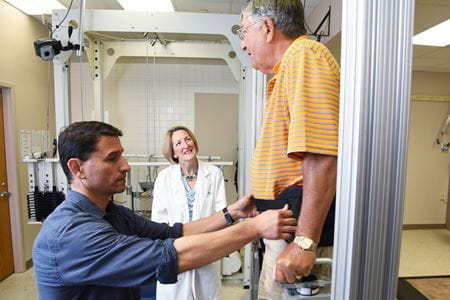High-intensity step training that mimics real-world conditions may better improve walking ability in stroke survivors compared to traditional low-impact training, according to new research in the American Heart Association’s journal “Stroke.”
“People who suffer strokes often have difficulty walking and impaired balance. Rehabilitation traditionally focuses on patients practicing low-intensity walking, usually only in a straight line in the forward direction, which does not provide enough of a challenge to the nervous system to enable patients to negotiate real-world situations, such as uneven surfaces, stairs or changing direction,” said study author T. George Hornby, PhD, professor of physical medicine and rehabilitation at Indiana University School of Medicine.
“Our study suggests that stroke patients can handle higher intensity and more difficult tasks than previously thought possible. We need to move beyond traditional, low-intensity rehabilitation to challenge the nervous and cardiovascular system so patients can function and perform better in the real world.”
Researchers tested 90 people 18- to 85- years-old with weakness on one side of the body who had survived a stroke at least six months prior.
Participants received training of either: high-intensity stepping performing variable, difficult tasks; high-intensity stepping performing only forward walking; or low-intensity stepping of variable tasks. Variable tasks included walking on uneven surfaces, up inclines and stairs, over randomly placed obstacles on a treadmill, and across a balance beam.
The researchers found:
- Survivors in both the high-intensity variable training and high-intensity forward walking groups walked faster and farther than the low-intensity variable training group.
- For all walking outcomes, 57 percent to 80 percent of participants in the high-intensity groups had important clinical gains, while only 9 percent to 31 percent of participants did so following low-intensity training.
- High-intensity group participants also improved the symmetry of their gait and stability while walking, balance and balance confidence.
Hornby noted that no serious adverse events, such as deaths or hospitalizations, occurred during the training sessions, suggesting stroke survivors can be pushed harder during rehabilitation.
The study was small compared to larger, multicenter clinical trials. Hornby said the next step would be to test high-intensity variable step training in larger patient populations in a large multicenter clinical trial. Ultimately, the goal is to incorporate high-intensity variable step training into regular clinical rehabilitation.
“Rehabilitation that uses normal walking without challenging the nervous system doesn’t do enough to make a statistical or clinically significant difference in a patient’s recovery,” Hornby said. “When stroke patients are pushed harder, they see greater changes in less time, which translates into more efficient rehabilitation services.”
Co-authors are Christopher E. Henderson, PhD, Abbey Plawecki, DPT, Emily Lucas, B.S., Jennifer Lotter, DPT, Molly Holthus, DPT, Gabrielle Brazg, DPT, Meghan Fahey, DPT, Jane Woodward, DPT, Marzieh Ardestani, PhD, and Elliot J. Roth, MD. Authors report no disclosures.
###
IU School of Medicine is the largest medical school in the U.S. and is annually ranked among the top medical schools in the nation by U.S. News & World Report. The school offers high-quality medical education, access to leading medical research and rich campus life in nine Indiana cities, including rural and urban locations consistently recognized for livability.
The American Stroke Association is devoted to saving people from stroke — the No. 2 cause of death in the world and a leading cause of serious disability. We team with millions of volunteers to fund innovative research, fight for stronger public health policies and provide lifesaving tools and information to prevent and treat stroke. The Dallas-based association officially launched in 1998 as a division of the American Heart Association. To learn more or to get involved, call 1-888-4STROKE or visit StrokeAssociation.org. Follow on Facebook and Twitter.




